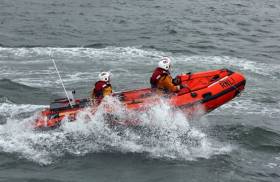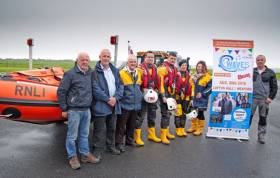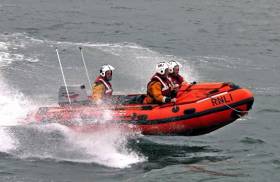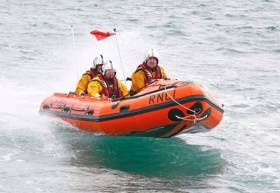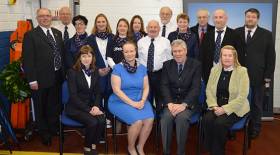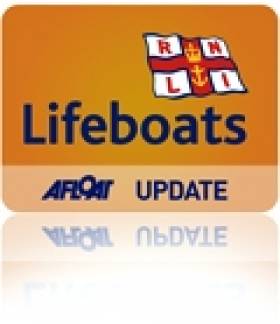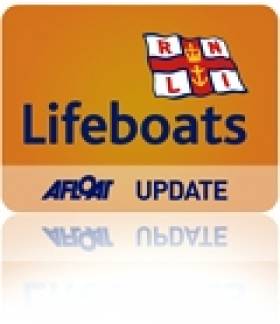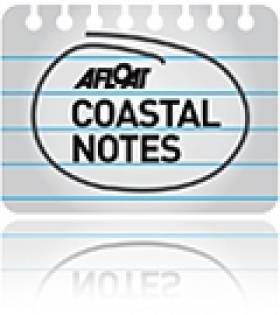Displaying items by tag: Fethard
Fethard Lifeboat Launches To RIB With Fouled Propeller
#RNLI - Fethard RNLI's inshore lifeboat Tradewinds launched yesterday afternoon (Sunday 17 July) to a 6m RIB with a fouled propeller off Woodstown Strand in Waterford.
The RIB got into difficulty when its propeller became entangled in mussel cages within the shellfish bed area off of Woodstown Strand, leaving it stranded.
There was six people, four male and two female, on board the RIB, all of whom were wearing lifejackets.
The Fethard lifeboat launched from Duncannon, with good weather and a south-westerly wind of Force 2-3, and arrived with the casualties at 4pm.
The volunteer lifeboat crew were required to take some passengers off the RIB to help propel the craft up and enable them successfully to release the propeller from the mussel cages.
Once released, the RIB was towed by the lifeboat to deep water where its engine was restarted. The lifeboat then accompanied the RIB back to Dunmore East.
Speaking following the callout, Fethard RNLI deputy launching authority Tony Molloy said: "The casualties did the right thing in calling for assistance. They did not panic, stayed clam and all members were wearing lifejackets.
"The RNLI crew were on scene swiftly prior to high tide due at 5pm, therefore there was no imminent danger or any requirement for the casualties to abandon their RIB."
Molloy added: "It is important to watch out for safety markers off of our coastline, as such help notify boaters of potential hazards.
"In this instance they had VHF and prior to launching had determined the best course of action to take if they were to get into trouble.'
Two days previously Fethard RNLI launched to a 21-foot lobster boat with a fouled propeller one mile from Baginbun Head.
The volunteer lifeboat crew were able to release the rope and the fishing vessel, with one on board, returned to Fethard Dock under its own steam.
In other Fethard lifeboat news, funds will be raised for the long-running lifeboat station at the inaugural Waves Music Festival next month, as previously reported on Afloat.ie.
Fethard RNLI Launches Major Festival For Lifeboat Appeal
#RNLI - Irish country music sensation Nathan Carter is set to headline the inaugural Waves Music Festival on Sunday 28 August 2016 at Loftus Hall in the historic coastal area of Hook Head.
The family-themed day-long music event is being run in aid of the Fethard RNLI fundraising appeal, which is set to raise €65,000 needed for a new inshore lifeboat due to be placed on service in Fethard at the end of 2017.
Performing alongside Nathan Carter will be home-grown group Corner Boy and new to the Irish music scene, Wexford’s own Elmore.
A further act is set to be announced in the next few weeks which will be cause a great deal of excitement among the teenage audience, ensuring that the day appeals to all the family.
RNLI in conjunction with Beat will be providing the opportunity for one lucky artists within the south east to perform live and kick off the festival on the Sunday.
Momentum Events have joint forces with the Fethard RNLI fundraising team and will create a dedicated family kids area within one of the walled gardens. This will allow a secure play area for the full family to enjoy.
Loftus Hall proprietor Aidan Quigley said: "Loftus Hall is delighted to support the RNLI and offer our unique and unusual venue for the event. This year Loftus Hall celebrates its 666th anniversary."
Fethard RNLI volunteer lifeboat press officer Rebecca Doyle also commented: "The Waves Music Festival is the first music festival the RNLI have undertaken in the South East and it is a huge privilege for us to be given this opportunity.
"The event has a capacity of up to 5,000 people and a purpose built event site will be created at Loftus Hall for the occasion, creating a picnic style theme for the summer event.
"We are particularly thrilled to have an artist of the calibre of Nathan Carter play the festival. Nathan has a huge following in Ireland and his shows have been packing out venues across the country.
"We hope that people locally will support this great event and that we will welcome many visitors to the area on the day. While loads of fun will be had, this festival has its roots in a great cause and that is saving lives at sea and supporting the work of the charity on the South East coast."
Gates open at 11am and the concert finishes at 8pm. Tickets for the daylong event are €25 each with €85 for a family of four. For more information visit www.wavesfestival.ie.
Fethard Lifeboat Launches In Search For Missing Person
#RNLI - Fethard RNLI launched their inshore lifeboat yesterday afternoon (Wednesday 20 April) following concerns that a person may have been missing on the Hook Peninsula in Co Wexford.
The alarm was raised when a man did not return from a walk at Hook Head when expected.
The volunteer lifeboat crew responded quickly to a launch request by the Irish Coast Guard following the report at 4.30pm.
The D-class lifeboat Tradewinds, helmed by John Colfer together with three volunteer lifeboat crew, launched at Slade Harbour within minutes following the pager alert, assisted by five shore crew who began a shoreline search.
At 5.15pm the search was stood down with the notification that the man was found safe and well.
Speaking following the callout, Fethard RNLI deputy launching authority Hugh Burke said: "We would like to commend the member of the public who raised the alarm today when they were concerned. We would always rather launch to a false alarm with good intent than not launch at all.
"Our volunteers responded quickly this afternoon to aid in the search at sea and on the shore but we were stood down quickly on hearing the good news that the man was not missing but overdue and had been located safe and well."
Fethard RNLI is always looking for new volunteers from all walks of life to join their lifesaving team.
If you are aged 17 or over and would like to find out more please contact the lifeboat station or make a visit during its May Bank holiday open weekend.
#RNLI - Four local towns went head-to-head at a recent quiz night in a bid to raise funds for Fethard RNLI’s new inshore lifeboat appeal.
Some 62 tables took on the challenge in four venues in Fethard on-Sea, Duncannon, Campile and New Ross last Friday (1 April) to determine which village or town would take the ‘Don’t be a fool on April Fool’s Day’ crown.
The honours went to New Ross on the night, with the winning team represented by Luke Grennan, Dan Meaney, Pat Kenny and Denis North.
Speaking following the event, Fethard RNLI fundraising chair Oonagh Hearne said: "Around 248 people enjoyed a great family evening with 62 tables participating and helping us to raise €3,000 towards our new inshore lifeboat appeal.
"Thank you to everyone who supported the event including The Brandon House Hotel, Neville’s Bar, Dunphy’s Bar and the Strand Tavern. Thanks to everyone who took part, the companies who donated prizes and all who helped organise the event. The community spirit was incredible."
Fethard RNLI hopes to raise €65,000 in their 18-month fundraising appeal which will go towards the cost of a new D class lifeboat due to arrive at the station late next year.
Fethard RNLI Launches €65,000 Appeal For New Lifeboat
Friends and supporters of Fethard RNLI gathered together at the lifeboat station this weekend on the one hundred and second anniversary of the Mexico disaster, where nine lifeboat crew lost their lives off the Wexford coast, to launch an appeal for a new lifeboat. As the current lifeboat Trade Winds nears the end of its service, an 18-month appeal has been launched to raise the €65,000 needed for a new D class lifeboat.
Opening the proceedings Fethard RNLI Chairman John Hearne remembered those lifeboat crew lost 102 years ago. He said, ‘Walking through the station today you will see pictures of those men and that previous lifeboat (Helen Blake) and you may think that there is a world of difference between then and now. Of course now the lifeboats look completely different and the technology today is a world apart but it all counts for nothing without the crew. The RNLI is still the same charity that it was in 1914 and the work it does of saving lives at sea is still carried out by volunteers in exactly the same tradition.’
‘The technology marches on and soon this lifeboat will have completed ten years arduous service. The very best way that we in the community can support this fine crew is to give them the best equipment and training to do what can be a most difficult job.’
Colin Williams RNLI Divisional Operations Manager acknowledged the role played by the community twenty years ago when the station reopened followed its closure after the Mexico tragedy.
Colin said, ‘When the RNLI looked at reopening Fethard the old lifeboat station was being used by local fishermen. It’s a testament to the community’s feeling toward the lifeboat service that they returned it to the RNLI and Fethard RNLI reopened. Since then there have been many notable rescues. The volunteers crew here today are the custodians of the lifeboat service and we owe much to the local committee, twenty years ago, who lobbied so hard to have the RNLI look again at having a lifeboat stationed at Fethard.
Fethard RNLI Fundraising Chairperson Oonagh Hearne spoke on the challenges of raising €65,000 for the new lifeboat. ‘We have a very strong committee and we are going to do our very best. Everyone who lives on the peninsula knows how much we need this lifeboat and we have already had many expressions of support and interest. We will be keeping everyone updated our events and I want to thank those who have already pledged their support.’
Niamh McCutcheon, a member of the RNLI Council of Ireland travelled especially to Fethard for the launch to officially launch the appeal. Addressing the crowd she said, ‘The community of Fethard and its friends will be the donors of your new lifeboat. You have an eighteen month journey ahead to raise the funding and it will be hard work but rewarding work. After which you will know that every time that new lifeboat launches, every one of you made it possible. Every life saved or person helped to safety by your new lifeboat will be a community effort because your community funded your new lifeboat.’
The occasion also served to recognise the contribution of two Fethard RNLI volunteers who in different ways have served the station with distinction. Hugh Burke a former helm with the lifeboat and a current launching authority was presented with a framed Letter of Thanks from the RNLI Chairman in recognition for his skill and split second decision-making during a daring rescue last March.
The callout was to a young man got into extreme difficulty after he launched a kayak near Baginbun Head when his dog fell down a very steep gully. His kayak overturned and he was trapped in a three metre wide gulley within a pool of water with submerged rocks. He was being pummelled by the broken water and was in imminent danger of being swept out to sea. Under the command of Helm Hugh Burke the lifeboat entered the gulley and along with his fellow crew, Nicolette Perrella and Stephen Byrne, they rescued the man.
Accepting the Letter of Thanks from the RNLI Hugh spoke of his time on the lifeboat crew and the affection for the station’s inshore lifeboat.
‘I remember coming down to the station 20 years ago to view the new D class inshore lifeboat. I wondered what can a little boat like this do to make a difference as I was used to bigger boats. But after training on it I was amazed at what this little boat can do. We have 12 lifeboat launching sites in the area and have carried out 258 launches on it. If our pagers went off now we have three lifeboat crew on standby to launch immediately and we know we have the right tool for the job.’
Also honoured was former Fethard RNLI Fundraising Chairman Hugh Stafford who recently stepped down from his role and who had been honoured with the Institution’s Gold Badge for his services to the charity.
The afternoon concluded with a wreath laying at the memorial for the nine lifeboat men who lost their lives during the rescue of the Mexico and was followed by a minutes silence by the assembled crowd.
Fethard RNLI Launch Lifeboat to Kite Surfer off Duncannon Beach
Lifeboat crew with Fethard RNLI in Wexford launched yesterday afternoon to assist a kite surfer who had got into difficulty off Duncannon beach in Wexford. The alarm was raised shortly after 2pm when the man could not safely return to shore and was in danger of drifting out to sea.
Fethard RNLI operates an inshore lifeboat which can be launched from multiple locations by Land Rover. For this callout the lifeboat crew travelled from the station to Duncannon and launched to reach the casualty as quickly as possible.
Deputy Launching Authority Hugh Burke also travelled to the location to spot the kite surfer from the beach and keep in contact with the Coast Guard. The casualty was sighted a kilometre away from the beach where he had rolled up his lines and folded the kite down, using it as a sail to guide him inland.
The kite surfer was blown onto shore at Glen Bay, a short distance away and was awaiting help. However with high cliffs making communication with the lifeboat difficult and an obstructed view with the casualty’s clothing blending into the background it was impossible to guide the lifeboat to his exact location. The casualty worried that he had been missed by the lifeboat and the Coast Guard helicopter, which was also on scene and started to make his way inland through fields, leaving his gear behind him on the beach.
The lifeboat crew came upon his equipment a short time later, immediately recovered it on board and continued to search, unaware that the casualty had continued on foot overland.
Fearing the worst Hugh and the two members of the RNLI shore crew took the RNLI launching vehicle and proceeded to the spot where they had observed the man being blown in, to see if they could locate him. A short time later they met him making his way back to Duncannon over land. He was immediately taken into the vehicle where he showed no signs of injury and was brought to be reunited with his relieved family at Duncannon pier.
Commenting on the callout Fethard RNLI Deputy Launching Authority Hugh Burke said, ‘It wasn’t your usual type of callout for the lifeboat crew. I think it was the first time the launching vehicle and not the lifeboat brought someone to safety. However we are delighted that the man was found safe and sound. The lifeboat crew feared the worst when they came across his equipment and found no sign of him.
He did the right thing when he realised he was in trouble and made sure he folded up his gear so that he wouldn’t be blown out to sea and tried to steer inland. Conditions were not great with rain, low cloud and a south-easterly wind of force three to four so we are relived it had a good outcome.’
Lifeboat crew on the callout were Helm Rory O’Connor with Cathal O’Connell and Nicolette Perrella and Shore Crew Mark Brenna and Jack Butler
Unmanned Yacht Aground off Hook Head
A 10–metre catamaran type yacht that ran aground two miles north of Hook Head, in County Wexford, Ireland is believed to have drifted free from its moorings.
Volunteer lifeboat crew launched yesterday morning following reports of the grounded cruiser. On arrival, the lifeboat crew found the unmanned yacht sitting deep in the water, perilously close to the rocks.
First on scene was Fethard RNLI Inshore lifeboat whose crew established a tow with the yacht, however this proved unsuccessful.
Shortly after, Dunmore East RNLI Lifeboat arrived on scene and put two crew on board the casualty vessel with a pump to try and drain the water from the yacht and establish a tow to recover it to a nearby harbour.
However, once on board, the lifeboat crew discovered that the yacht had taken on a large amount of water and that it was in danger of sinking. When they attempted to establish a tow the vessel dangerously dipped low into the water and the attempt was abandoned.
The Irish Coast Guard Rescue Helicopter Rescue 117 were also called out to the incident.
A decision was taken to leave the vessel as it was determined that the crew were in danger if they stayed on the yacht.
RNLI Marks Centenary Of Fethard Lifeboat Tragedy
#RNLI - One hundred years ago, nine volunteer lifeboat crew from Fethard RNLI lost their lives as lifeboat crews rescued 10 people after Norwegian vessel, the Mexico, struck rocks off the Wexford coast.
Hundreds of people gathered to attend events in Wexford this weekend to mark the centenary of the Fethard lifeboat tragedy.
At Fethard Quay, four RNLI lifeboats from Fethard, Rosslare, Dunmore East and Kilmore Quay gathered, and their lifeboat crews lay wreaths in the sea from the lifeboat stations, relatives of the lifeboat men who were lost and of those who survived, along with wreaths from relatives of the crew of the Mexico who had travelled from Norway for the anniversary.
Lifeboat Crews Tow Vessel From Rocks Off Waterford
#Lifeboats - TheJournal.ie reports that RNLI lifeboat crews from Dunmore East and Fethard rescued two fishermen from their vessel off the Waterford coast yesterday (14 January 2013).
Rescuers sped to the scene after the 10-metre fishing boat got into difficulty and grounded close to the shore north of Loftus Hall.
Despite the receding tide, the lifeboats managed to tow the vessel carefully off the rocks "without any major damage", according to a spokesperson. The two crew were uninjured in the incident.
It marked the third major call-out in a week off the Waterford coast - following a similar rescue effort last Tuesday, and just days after the tragic loss of a local fisherman on Thursday morning on the sixth anniversary of the sinking of Dunmore East trawler the Pere Charles.
Meanwhile, on Sunday afternoon volunteers with Achill Island RNLI went to the assistance of an injured fisherman off the Mayo coast.
The lifeboat station received the distress call around noon to go to the assistance of a fishing party north of Clare Island, where the crew removed a man from the vessel who had suffered an eye injury from a fishing hook.
He was subsequently transported on the lifeboat to Kildavnet, where a local doctor examined his injury before referring him to Castlebar General Hospital for further attention.
Coastal Harbours Benefit from Infrastructure Funding
Malahide is one of over a dozen harbours around the coast to benefit from an announcement by Sean Connick TD, Minister of State at the Department of Agriculture, Fisheries and Food today that funding has been approved for harbour development projects in Local Authority owned harbours under the Fishery Harbour and Coastal Infrastructure Development Programme 2010.
Funding has been approved for projects that have been identified as priorities by each of the five Local Authorities listed below. Up to 75% of the cost of an approved project (subject to the maximum figure approved) will be available for each project with the Local Authority providing the balance. The project must be completed and funding drawn down before the end of the current calendar year. The projects are located in harbours around our coastline that are in Local Authority ownership.
Minister Connick said “The Local Authority owned fishing harbours supplement and underpin the activities undertaken in our Department of Agriculture, Fisheries and Food owned Fishery Harbour Centres. These harbours are of great importance to the fishing and aquaculture industries and provide much needed employment and support for economic activity in our coastal communities. I am delighted to be able to announce the provision of this funding to enhance and develop these facilities”.
The following is a list of the Local Authorities that have been approved funding:
|
Local Authority |
Approved Funding |
||
|
FINGAL COUNTY COUNCIL |
|||
|
Malahide - Repair to slipway |
€55,875 |
||
|
SLIGO COUNTY COUNCIL |
|||
|
Mullaghmore Harbour - Dredging of harbour |
€90,000 |
||
|
CORK COUNTY COUNCIL |
|||
|
Ballycotton - Breakwater Emergency works |
€225,000 |
||
|
WEXFORD COUNTY COUNCIL |
|||
|
Fethard harbour 1 - Fishing harbour and slipway study |
€18,750 |
||
|
Fethard Harbour 2 - Fishing harbour and slipway |
€7,500 |
||
|
Kilmore Quay Harbour - Provide a new laydown area at the end of West Pier |
€54,750 |
||
|
Courtown Harbour 1 - Health & Safety improvements |
€18,750 |
||
|
Duncannon & Hook Peninsula Piers - New CCTV system & Harbour Repairs |
€56,250 |
||
|
WEST CORK COUNTY COUNCIL |
|||
|
Castletownbere - Bank Harbour |
€18,422 |
||
|
Bantry- Doneen Pier |
€23,288 |
||
|
Schull - Lahertanavally Pier |
€24,375 |
||
|
Schull - Ballycummisk Pier |
€19,916 |
||
|
Castletownbere - Trafrask Pier |
€18,422 |
||
|
Western Division - Safety Works |
€46,369 |
||
|
Bantry Pier - Public Toilets |
€30,000 |
||
|
|
|
|
|
|
|
|
Total Estimated Cost |
€707,667 |



























